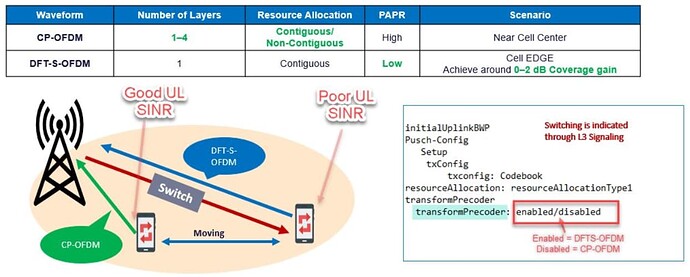What is NR WaveForm Feature?
Waveform Types:
3GPP has specified two waveforms for New Radio (NR) based upon Orthogonal Frequency Division Multiplexing (OFDM):
1- Cyclic Prefix OFDM (CP-OFDM). applicable to both the uplink and downlink
2- Discrete Fourier Transform Spread OFDM (DFT-S-OFDM). applicable to the uplink only
CP-OFDM Vs DFT-S-OFDM Performance:
- CP-OFDM has a high Peak-to-Average Power Ratio as it is supporting MIMO (Up to 4 Layers). This means that CP-OFDM offers improved throughput and capacity in excellent radio conditions.
- CP-OFDM is characterized by flexible resource allocation. However, this allocation of resources can produce a high peak to average power ratio (PAPR).
- DFT-S-OFDM has a lower Peak-to-Average Power Ratio (PAPR) than CP-OFDM. This allows the UE to transmit with a higher average power and so improves the uplink coverage performance.
- 3GPP has specified that DFT-S-OFDM only supports single stream transmission, i.e., MIMO is not supported.
- DFT-S-OFDM requires contiguous frequency-domain resources and ensures low PAPR and high transmit power.
- This means that CP-OFDM offers improved throughputs and capacity, while DFT-S-OFDM offers improved coverage.
Feature Activation Conditions:
- In the case of MSG3, DFT-S-OFDM may be selected to cater for all coverage conditions across the cell.
- In the case of subsequent PUSCH transmissions, the Base Station may dynamically reconfigure the UE according to coverage conditions.
- The Base Station selects the waveform to be used for the PUSCH and provides instructions to the UE.
- In the case of MSG3 belonging to the random-access procedure, instructions are provided within SIB 1 or alternatively can be provided using dedicated signaling.
- Dedicated signaling is used to provide instructions for subsequent PUSCH transmissions.
Observation From Pervious testing:
- Feature Verification from field testing can be checked through observing RRC Reconfiguration message, transformPrecoder. If enabled this means DFTS-OFDM is taking effect.
- After the uplink waveform adaptation function is enabled, UEcompatibility issues may occur on UEs not supporting the DFT-S-OFDM waveform, causing service drops.
- I didn’t observe much gain after enabling the feature; However the feature gain might be observed in the very deep indoor coverage.
***Activation is based on UL PUSCH SINR. Based on the UL SINR, the network side instructs the UE to select a proper CP-OFDM or DFT-S-OFDM waveform.
LinkedIn: ![]()
